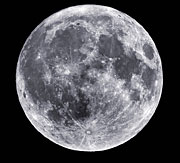- Number 345 |
- September 5, 2011
New wrinkle on age of man in the moon

How old is the moon?
How old is the moon? Maybe younger than the 4.5 billion years that scientists, until now, accepted as its age after analysis of moon rocks gathered during the Apollo missions.
New research using a technique that measures the isotopes of lead and neodymium in the lunar crustal rocks shows that the moon and even the Earth may have actually formed millions of years later.
Lawrence Livermore National Laboratory scientist Lars Borg and international collaborators analyzed three isotopic systems, including the elements lead, samarium and neodymium found in samples of ferroan anorthosite (FAN), a type of moon crustal rock, which is considered to represent the oldest lunar crustal rock type.
Borg said that these analyses showed that the moon likely solidified significantly later than most previous estimates or that the long-held belief that FANs are leftovers from a primordial magma ocean is incorrect.
Furthermore, said Borg, "If our analysis represents the age of the moon, then the Earth must be fairly young as well. This is in stark contrast to a planet like Mars, which is argued to have formed around 4.53 billion years ago. If the age we report is from one of the first formed lunar rocks, then the moon is about 165 million years younger than Mars and about 200 million years younger than large asteroids."
According to his team’s calculations, the moon is probably 4.36 billion years old.
[Lynda Seaver, 925.423.3103,
seaver1@llnl.gov]
